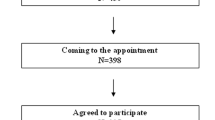Abstract.
Ambulatory blood pressure monitoring (ABPM) was performed in 29 children, ages 8.5–10.5 years (mean 11.6±3.0) with isolated haematuria (IH) and in 27 age, sex, weight and height matched healthy controls (C). Isolated haematuria was defined as ≥5 RBC/HPF on three separate urinalyses over a 3-month period with normal renal function, a normal appearing ultrasound examination of the kidneys and the absence of hypercalciuria. Haematuria had been documented for at least 3 years prior to ABPM. Daytime and nighttime periods were 0800–2200 and 2200–0800 hours, respectively. The total number of successful blood pressure readings was 21.8 and 20.7 per subject (90.0 and 86.1% of all attempted measurements) in IH and C, respectively. Mean 24-h, daytime and nighttime heart rate, mean arterial pressure, and systolic and diastolic blood pressure in IH did not differ from that of controls. Nocturnal dipping was present in all IH patients and was of equal magnitude to C (9.5 vs 8.4 and 13.7 vs 10.3% for average systolic blood pressure (SBP) and diastolic blood pressure (DBP) dips, respectively). We conclude that normal blood pressure values, as well as the circadian rhythm of blood pressure, are maintained in children with IH of at least 3 years' duration.
Similar content being viewed by others
Author information
Authors and Affiliations
Additional information
Electronic Publication
Rights and permissions
About this article
Cite this article
Pomeranz, A., Libman, L., Pomeranz, M. et al. Ambulatory blood pressure monitoring in children with isolated haematuria. Pediatr Nephrol 17, 938–942 (2002). https://doi.org/10.1007/s00467-002-0887-1
Received:
Revised:
Accepted:
Issue Date:
DOI: https://doi.org/10.1007/s00467-002-0887-1




